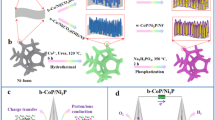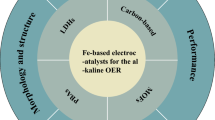Abstract
This work represented the electrocatalytic properties of Ni-doped titania hollow sphere materials in hydrogen and oxygen evolution during water electrolysis from acidic media. Titania hollow sphere particles were synthesized using poly(styrene-methacrylic acid) latex as template material, and various amount of nickel were doped over the sphere using nickel (II) sulfate as the precursor of nickel. The presence of rutile TiO2 and NiO phases were revealed during XRD analysis, indicating the critical growth of nickel on the surface of the hollow sphere catalysts. BET surface area results also shown the 166.76 m2 g−1 value for 30 wt% Ni/TiO2 hollow sphere sample. The SEM and TEM images were confirmed the hollow sphere structure of the catalysts with diameter of 0.8–0.9 μm. The cyclic voltammetric studies proved the presence of both hydrogen and oxygen evolution peaks for all the hollow sphere samples. The anodic peak current density value, which usually represents the oxygen evolution phenomenon, was revealed as 13 mA cm−2 for 25 wt% Ni-loaded sample; whereas, the hydrogen evolution peak was most intense for 30 wt% Ni/TiO2 material with cathodic peak current density of 32 mA cm−2. The average value of −1.42 were determined as the reaction order of the system irrespective of the nickel loading and heating duration in the synthesis of hollow sphere materials. During photocatalytic water splitting, 30 wt% Ni/TiO2 hollow sphere sample yielded the highest amount of hydrogen in all irradiation time span.














Similar content being viewed by others
References
Patterson J, Ramsey B, Harrison D. http://dspace.brunel.ac.uk/bitstream
Friedland R, Speranza AJ (1999) DOE Hydrogen program review. In: Proceedings of the 1999 U.S., vol 1. National Renewable Energy Laboratory No. NREL/CP-570-26938 Golden, Colorado
Peavey M (2003) Fuel from water energy impendence with hydrogen. Merit Products, USA
Chandler GK, Genders JD, Pletcher D (1997) Platinum Metals Rev 41:54–63
Reinhardt D, Krieck S, Meyer S (2006) Electrochim Acta 52:825–830
Bamwenda GR, Ueisigi T, Abe Y, Sayama K, Arakwa H (2001) Appl Catal A 205:117–128
Contescu C, Popa VT, Miller JB, Ko EI, Schwarz JA (1996) Chem Eng J Biochem Eng J 64:265–272
Odobel F, Blart E, Lagree M, Villieras, Boujtita N, Murr E, Caramori S, Bignozzi CA (2003) J Mater Chem 13:502–510
Pessoa CA, Gushikem Y, Nakagaki S (2002) Electroanalysis 14:1072–1076
Pessoa CA, Gushikem Y (1999) J Electroanal Chem 477:158–163
Yoshihiko K, Yoshikawa H, Agwa K, Murayama M, Mori T, Sunada K, Bandow S, Ijima S (2008) Langmuir 24:547–550
An K, Lee N, Park J, Kim CS, Hwang Y, Park JG, Kim JY, Park JH, Han JM, Yu J, Hyeon T (2006) J Am Chem Soc 128:9753–9760
Graf C, Dembski S, Hofmann A, Ruhl E (2006) Langmuir 22:5604–5610
Zhu YZ, Chen HB, Wang YP, Li ZH, Cao YL, Chi YB (2006) Chem Lett 35:756–757
Fujiwara M, Shiokawa K, Hayashi K, Morigaki K, Nakahara Y, Biomed J (2007) Mater Res A 81:103–112
Shiho H, Kawahashi N (2000) J Colloid Interface Sci 226:91–97
Kawahashi N, Shiho H (2000) J Mater Chem 10:2294–2297
Yoon SB, Kim JY, Kim JH, Park SG, Kim JY, Lee CW, Yu JS (2000) Curr Appl Phys 6:1059–1063
Wang C, Ao Y, Wang P, Hou J, Qian J, Zhang S (2010) J Hazard Mater 178:517–521
Chattopadhyay J, Kim HR, Moon SB, Pak D (2008) Int J Hydrogen Energy 33:3270–3280
Son JE, Chattopadhyay J, Pak D (2010) Int J Hydrogen Energy 35:420–427
Tucker SH (1950) J Chem Ed 27:489
Changwei X, Yonghong H, Rong J, Jiang SP, Yingliang L (2007) Electrochem Commun 9:2009–2012
Nishida R, Kakinuma K, Nishino H, Kamino T, Yamashita H, Watanabe M, Uchida H (2009) Solid State Ionics 180:968–972
Mahesh RA, Jayaganthan R, Prakash S, Chawla V, Chandra R (2009) Mater Chem Phys 114:629–635
Kim H, Eom Y, Lee T, Shul Y (2008) Mater Chem Phys 108:154–159
Gregg SJ, Sing KSW (1982) Adsorption, surface area and porosity, 2nd edn. Academic Press, New York
Woods R (1976) In: Bard A (ed) Chemisorption at electrodes in electroanalytical chemistry, vol 9. Marcel Dekker, New York
Czerwinski A (1994) J Electroanal Chem 379:487–493
Diebold U (2003) Surf Sci Rep 48:53–229
Niklasson GA, Granqvist CG (2007) J Mater Sci 17:127–156
Lide DR (2000) CRC handbook of chemistry and physics, 73rd edn. CRC Press, Boca Raton
Lunkenheimer P, Loidl A, Ottermann CR, Bange K (1991) Phys Rev B 44:5927–5930
Trasatti S (1990). In: Wendt H (ed) Electrochemical hydrogen technologies Elsevier, Amsterdam, p 104
Hrussanova A, Guerrini E, Trasatti S (2004) J Electroanal Chem 564:151–157
Author information
Authors and Affiliations
Corresponding author
Rights and permissions
About this article
Cite this article
Chattopadhyay, J., Srivastava, R. & Srivastava, P.K. Ni-doped TiO2 hollow spheres as electrocatalysts in water electrolysis for hydrogen and oxygen production. J Appl Electrochem 43, 279–287 (2013). https://doi.org/10.1007/s10800-012-0509-y
Received:
Accepted:
Published:
Issue Date:
DOI: https://doi.org/10.1007/s10800-012-0509-y




